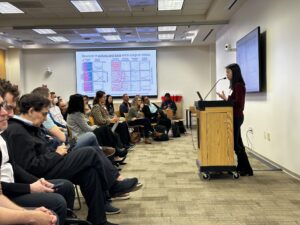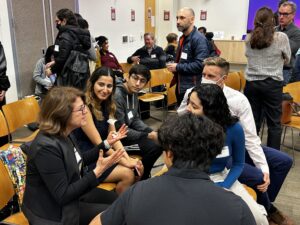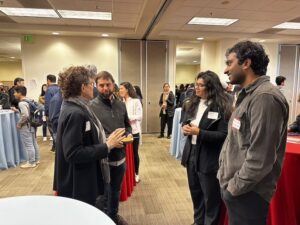January 23rd, 2024: 8:00AM to 1:30PM
Frances C. Arrillaga Alumni Center
Thank you to everyone who contributed to another successful C&C Forum, including attendees, faculty, panelists and externals partners who participated in the Collaboration Forum.



This Forum is designed to engage leaders from companies, government agencies and other organizations external to Stanford with our faculty, graduate students, postdocs and staff scientists. It offers a unique opportunity to discuss advancements in AI, data science and multimodal data integration to accelerate precision healthcare and medicine through a connection with our Department of Biomedical Data Science (DBDS) community.
Agenda:
8:00am-9:00am: Check in and light breakfast
9:00am-9:30am: Overview of DBDS Initiatives and 2024 Plans, from Department Chair, Sylvia Plevritis
9:30am-11:00am: Faculty lightning talks
- Aaron Newman, Professor of Biomedical Data Science Abstract
- Serena Yeung, Professor of Biomedical Data Science and, by courtesy, of Computer Science and of Electrical Engineering Abstract
- Nima Aghaeepour, Professor of Anesthesiology, Perioperative and Pain Medicine, of Pediatrics and, by courtesy, of Biomedical Data Science Abstract
- Manuel Rivas, Professor of Biomedical Data Science Abstract
- Tina Hernandez-Boussard, Associate Dean of Research; Professor of Medicine (Biomedical Informatics), of Biomedical Data Science, of Surgery and, by courtesy, of Epidemiology and Population Health Abstract
- Akshay Chaudhari, Professor of Radiology and, by courtesy, of Biomedical Data Science Abstract
- Nigam Shah, Chief Data Scientist for Stanford Health Care; Professor of Medicine and of Biomedical Data Science Abstract
11:00-12:00: Collaboration Forum with faculty, students, postdocs, companies and other outside organizations
12:00pm-12:30pm: Lunch
12:30pm-1:30pm: External Partners Panel: The Future of Research in Industry and Academia in the Age of AI, moderated by Bryan Bunning and Kristy Carpenter, PhD students
Panelists:
- Wei Li, Vice President and General Manager of Machine Learning Performance at Intel
- Aicha BenTaieb, Principal AI/ML Scientist at Genentech
- Jeffrey Venstrom, Chief Medical Officer at GRAIL
- Anitha Kannan, Founding Member/Head of Machine Learning at Curai
- Scott Penberthy, Managing Director, Applied AI, Office of the CTO at Google
View panelist bios here.
April 2, 2024
by DBDS Communications
“What we are experiencing is nothing short of a revolution,” Sylvia Plevritis, Department of Biomedical Data Science (DBDS) chair, said in her opening remarks for the second annual Collaboration and Careers Forum, which focused on AI and its role in precision healthcare, and kicked the forum off with a rousing start.
Hosted by DBDS, the forum drew more than 160 students, faculty, alumni, and industry leaders to discuss and learn about the newest innovations in AI, data science and multimodal data integration to advance precision health. The event, which took place on January 23, 2024, provided an opportunity for faculty, students, and DBDS researchers to discuss their projects with government agencies, foundations, and other organizations who share the overarching goal of accelerating precision medicine and healthcare.
Although only in its second year, the Collaboration and Careers Forum has been highly successful in connecting the DBDS community with external partners. The focus — pairing outside agencies with academic counterparts to learn and explore the burgeoning field of AI — resulted in an atmosphere abuzz with discussions of research and practical applications that have been developing in the precision medicine and healthcare field. Thirty-one leaders from sectors including industry, nonprofits, not-for-profits, and government agencies discussed their strategies, future goals, and current projects with attendees in the hour-long interactive career session.
“We are witnessing an AI revolution in data-driven health care, and our faculty and students are driving many aspects of it,” said DBDS Chair Sylvia Plevritis. “This yearly event is a fantastic time to connect across sectors toward advancing AI-driven initiatives in precision health.”
The forum began with opening remarks from Plevritis and Karen Matthys, Executive Director of Biomedical Data Science. They were followed by lightning talks — nine-minute presentations highlighting faculty research ranging in areas from “Using AI to Improve Surgeon Skill and Outcomes” by Serena Yeung to “Decoding Cellular Plasticity and Spatial Biology With Data Science” by Aaron Newman.
“We’ve developed several approaches for digital cytometry — one such approach is a machine learning method called CIBERSORTx,” Newman said in his presentation. “This method allows us to take single-cell expression data from a tissue type of interest, create a series of reference profiles that discriminate the various cell types in the tissue, and then use these reference profiles to dissect the cellular composition of large bulk tissue expression data sets, including data from tumors, blood draws, or archived expression data. CIBERSORTx can also determine gene expression profiles of individual cell types without physically isolating them. With these capabilities, CIBERSORTx can help us understand tissue composition in health and disease at massive scale.”
Serena Yeung explored the use of AI in providing automated assessment, feedback, and assistance to surgeons through computer vision-based interpretation of surgical video. She presented her lab’s ongoing work on developing computer vision methods that can perform fine-grained understanding of surgical video, and present applications towards improving surgeon training and identifying aspects of surgeon technique associated with outcomes.
“Preterm birth is the single largest cause of mortality in children under five years of age,” Nima Aghaeepour said during his lightning talk. “Despite decades of research, progress in developing diagnostics and therapeutics for these patients has been limited. We are using AI/ML methods to build a quantitative bridge between Stanford’s adult and children’s hospitals so that we can analyze mothers and babies as a single unit. This has allowed us to predict newborn outcomes far in advance (potentially even before birth) and to intervene early to give them the highest chances of survival.
Recent advances in statistical methods and computational power have enabled the analysis of large-scale datasets from population biobanks, Manuel Rivas explained in his presentation, leading to the discovery of novel therapeutic targets and pathways. He exemplified the path from statistical methodological development to target identification for glaucoma to therapeutic development using monoclonal antibodies to mimic effects of protective mutations in humans. He also discussed approaches for disease risk prediction using genetics, metabolomics, and proteomics data. The methods and applications he presented demonstrated the value of population-scale cohorts to advance understanding of disease and development of new treatments.
Tina Hernandez-Boussard presented on equitable AI in healthcare by cultivating AI solutions that provide benefit to all populations. By addressing bias, accessibility, and diverse representation, she said, we strive to build a healthcare AI framework that ensures fairness and benefits for all.
Akshay Chaudhari described the recent work in multi-modal vision-language pretraining for applications in radiology that his lab has been researching. He demonstrated the ability of multi-modal vision-language models for synthetic text-driven medical image generation as well as enabling few-shot understanding of medical images, and discussed potential applications and challenges of such generative and discriminative models in radiology.
In his lightning talk, Nigam Shah spoke of the immense excitement around the use of artificial intelligence to advance the science and practice of medicine as well as the delivery of healthcare, particularly the experience at Stanford Healthcare in shaping the responsible use of this technology in our health system. Shah discussed the use of FURM (Fair, Useful and Reliable AI Models) and stressed that we need to create an interface to ensure that we are using them in an AI-ready organization.
The career fair followed the lightning talks, and featured 31 representatives from a variety of organizations, some of which brought back DBDS alumni to discuss their research and work in AI. Some external partners, such as Sarah McGough, a principal data scientist in product development at Genetech/Roche, have already been establishing research projects with DBDS faculty in collaborations that have had promising results.
“I work a lot with Rob Tibshrani, James Zou, and Balasubramanian Narassimham,” McGough said. “I think these methods of collaborations are really important for us because it means that we can take and translate real world challenges that we see in biotech and actually bring in a lot of the thought leadership, a lot of the methods development to actually figure out how can we solve these with new computational tools.”
Alumnus Serge Saxonov, now the CEO and co-founder of 10X Genomics, returned to Stanford for the Collaboration and Careers Forum because he “loved his time at Stanford and the program — it’s always a pleasant time for me to come back and be around campus and meet people.”
“Every time I come here and see students and feel the energy of the place,” he continued, “the intelligence and the earnestness and the brilliance of the students in the program and around Stanford — I always feel really inspired and energized.”
A panel of industry executives and experts rounded out the forum, discussing “The Future of Research in Industry and Academia in the Age of AI,” moderated by Bryan Bunning and Kristy Carpenter, both DBDS Ph.D. students. It was a unique opportunity for forum attendees to learn and engage with top leaders with companies who are implementing AI in their strategies and research. The panel consisted of:
- Wei Li, Vice President and General Manager of Machine Learning Performance at Intel
- Aicha BenTaieb, Principal AI/ML Scientist at Genentech
- Jeffrey Venstrom, Chief Medical Officer at GRAIL
- Anitha Kannan, Founding Member/Head of Machine Learning at Curai
- Scott Penberthy, Managing Director, Applied AI, Office of the CTO at Google
The panel had differing opinions on the early wins that AI would enable in healthcare and medicine.
Penberthy expected the early successes would be more on the business and operations side, with improvements in diagnostics farther down the road. For Venstrom the panel was a reason to talk about what organizations are already incorporating AI into their diagnostics suite.
“I’m honestly most excited about new technologies and applications of artificial intelligence applied to the two biggest killers of Americans: Cancer and cardiovascular disease,” Venstrom said. “There’s this huge tsunami of new applications of advanced analytics and machine learning and products to improve people’s cardiovascular and oncologic or risk for cancer tools that is really going to change how we think about cancer, how we think about heart disease, and how we screen diagnose prevent and treat those two lethal areas.”
The technology to screen for more than 50 types of cancer using a simple blood test is already in place, he added. “That is a huge, transformative way of thinking about screening for cancer; of applying advanced analytics and machine learning to the genome and actually getting truly meaningful life-changing information out of this complex component of who we are.”
Kannan saw the opportunity with AI to work on prognosis. She cited that 40% of adults don’t have access to primary care physicians in the US. AI will address this challenge, and she expects we will see AI-assisted doctors in the next two to three years. Li also envisioned the opportunity in the near future with AI-assisted doctors through chatbots to help with point of care answering healthcare questions.
Other applications where Li envisioned strong potential included conversational AI to transcribe doctors’ conversations with patients in order for doctors to have. AI could assist in rural areas through remote connections between patients and healthcare providers including mental health care where such services may not exist. Li predicted a vast improvement in robotics in healthcare within only three years, which could also assist with those people aging at home.
One early win for AI, according BenTaieb, is the ability to summarize a body of published research in an accurate way faster than what is currently possible although unintended consequences would need careful consideration of.
On the instrument side, BenTaieb was excited about the way that AI may change the way experiments are executed in the lab, for instance, with analysis of complex genomics readouts that are unstructured and difficult to interpret. However, she expected successes will occur with administrative tasks, such as patient consent forms, as AI has the capacity to make the information we share with patients more understandable.
Along with all these opportunities, the panelists shared their thoughts and concerns about Responsible AI and health equity. They agreed that there is a strong need for more thought-through usage with guardrails in place. They also voiced their convictions that AI-generated solutions must be beneficial for all types of patients in order to be truly effective.
For DBDS students, the forum was the chance to meet and speak to industry and research leaders was not only informative, but revelatory. External partners were provided with a resume book containing the CVs of participants who will be seeking out opportunities post-graduation in this exact field.
“I’m honored to have been part of the Collaboration and Careers Forum, both as a student and as a member of the organizing committee,” Aditi Goyal, an Academic Research MS student. “Stanford has a unique advantage over other Biomedical Data Science programs given its location in the Silicon Valley. It’s exciting that we can leverage this to connect our students, faculty, and scientists with scientists and developers across various fields.”
Bunning felt that the most interesting takeaway for him was the consensus opinion among panelists that no one has any idea where the field will be five years from now.
“The pace of development and innovation is so fast right now surrounding healthcare, biotechnology, and AI,” he added. “It is a very exciting time to be in the field. Multiple panelists expressed feelings of envy they were not currently a trainee during this era, which was great motivation for trainees.”
Sohaib Hassan, also a DBDS Ph.D. student, was impressed by the way the forum enhanced student’s views on working in industry.
“Speaking to real people who are working in the industry every day, have new ideas, and are very down to earth helps us to connect well with them,” he said. “Many of the folks I spoke to mentioned AI and their companies’ use of it, and for the most part all of the representatives stated AI helped them and their colleagues perform better work. This also resonated positively with us students as we work with AI in our daily lives and have seen its positive effects.”
The forum helped students who are interested in working in industry, Perla Molina, also a Ph.D. student, noted. “I believe it can guide what part of the field exactly they would like to work in to improve the industry or AI itself,” she said. “I believe (the forum) also helps students interested in academia to also guide their own research and having considerations of incorporating AI into their work.”
For industry leader Saxonov, participating in the Collaboration and Careers Forum was not your average “student meets company” career fair. Despite being a start-up team member of 23 & Me, and now the CEO of his own well-established company 10X Genomics, he reflected on the advances that were made in the field since he was a Stanford student, and what that means for the future of the current students of DBDS.
“The fact is that right now is a really, really special time,” he said, “because of the variances that are happening in AI and computation and those advances. The nexus, the physical place where they’re happening is basically right here. It’s in the Bay Area, in Silicon Valley that it’s kind of hard to imagine a more exciting time or place than that. I loved my time here, but you know, if I had to choose being a student now or then, yeah, maybe now it would be even more exciting.”
